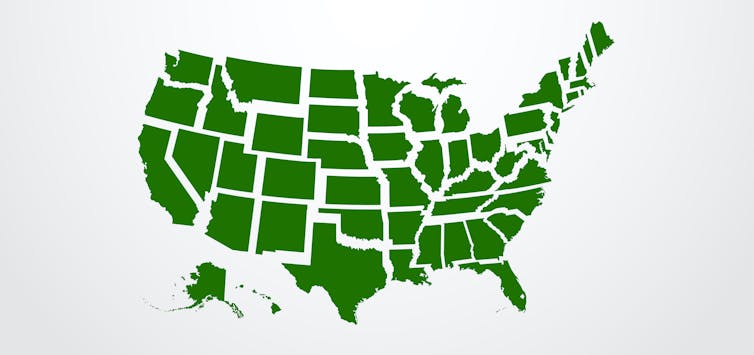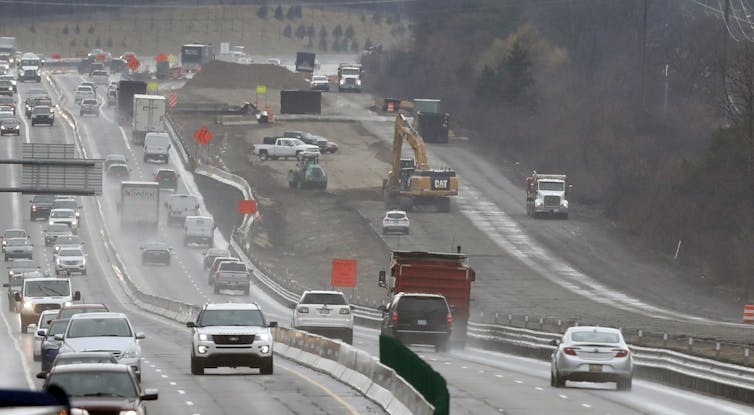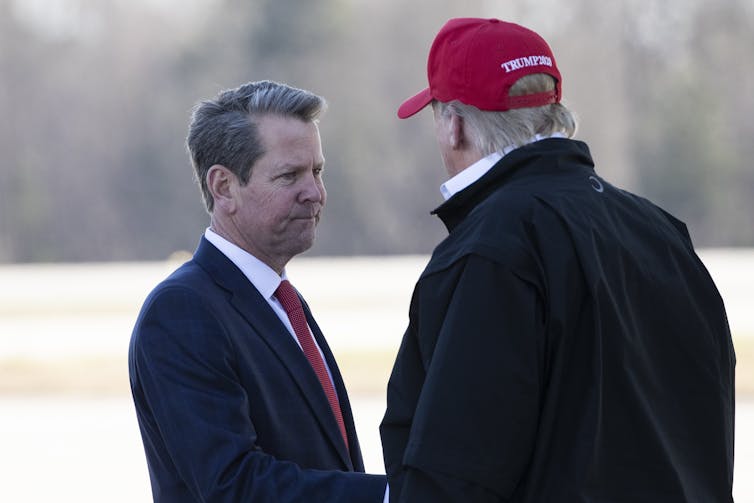
Experts in autocracies have pointed out that it is, unfortunately, easy to slip into normalizing the tyrant, hence it is important to hang on to outrage. These incidents which seem to call for the efforts of the Greek Furies (Erinyes) to come and deal with them will, I hope, help with that. As a reminder, though no one really knows how many there were supposed to be, the three names we have are Alecto, Megaera, and Tisiphone. These roughly translate as “unceasing,” “grudging,” and “vengeful destruction.”
I have another project which i am not going to be able to finish this week, but when I found this, I thought it was a great opportunity to reinforce a point I have been trying to make for years now. People talk constantly about the American justice system, how it works, how to reform it, when in fact there is no such thing. No single thing. Besides the Federal government, there fifty states, and, oh yeah, 7 territories (some of which are uninhabited), but any or all of which have or could have theoir own systems. I sometimes nod to counties and cities – but I would never have guessed that in the United States, we have more than 90,000 governments, had not Professor Swindell researched it – through the Census Bureau, no less – and cited it here (another reason the Census is so very important.) When one wants to talk about reforming justice system(s), this is a number to be reckoned with.
But it’s also pertinent to everyday, and not-so-everyday occurrences, such as pandemics. And I hope this article will give each of us, in our own separate circumstances, better insight into just who is in charge here.
================================================================
Who’s in charge of lifting lockdowns?

David Swindell, Arizona State University
In a nation with more than 90,000 governments, responses to the coronavirus pandemic have highlighted the challenges posed by the United States’ system of federalism, where significant power rests with states and local governments. Wisconsin’s Supreme Court just overturned their governor’s order for residents to stay at home – and then several cities and counties imposed their own restrictions, very similar to the governor’s rules.
So who’s running the show?
I am a scholar of how different levels of government interact and work together to deliver public services, and my answer is: It depends.
At the national level, President Donald Trump has both told the 50 states to fend for themselves, and also claimed to have the authority to force states to “reopen.”
In the absence of nationwide coordination and leadership, governors have made their own decisions about how to contain the spread of the virus. Their decisions apply only to their own states, making the country a patchwork of varying efforts.
And as state governments start to lift their lockdown restrictions to varying degrees, the patchwork gets even more complicated. Then factor in the powers and responsibilities of more than 3,000 counties, nearly 20,000 municipalities and almost 13,000 public school districts around the country, and it becomes clear that the answer to “Who’s in charge?” is not so simple.
Who actually has the power to make binding decisions mostly depends on two factors. First, there’s what’s being decided: Is it about public health, police, hospitals, schools, barbershops or other businesses? Second: It depends on the state.

Local control
Historically, the U.S. has divided responsibilities for different services and functions across levels of government, so they could be tailored to regional preferences where possible.
For instance, jails are run locally or by counties; businesses get municipal and state licenses. Similarly, animal control laws, zoning and pothole repairs are typically handled by local governments, not at state or federal levels. States typically regulate businesses and industries, oversee welfare programs and manage major highways.
The national government handles things where widespread coordination and standards are important, like national defense, Social Security, space exploration and trade between states.
Before the Great Depression, state and national government duties were more clearly differentiated. But since the 1930s, this system has evolved, and the distinctions between which levels do what have blurred and blended.
For instance, states are in charge of public K-12 schools and public universities, but the federal government ensures school districts comply with rules about equal access for all students, and provides grants to support needy children and university research.
Likewise, state governments build and maintain the interstate highways, but the federal government pays many of the costs.
Today, this mixing of responsibilities has made difficult a nationally coordinated response to a pandemic whose effects are mostly local. State and local officials have tried to respond as best as possible, but they do not have the information or buying power of the federal government.
The federal government may claim to be able to shut down the economy, but the truth is that states are the ones responsible for regulating the businesses that operate within their boundaries. So the federal government can’t order states to close down or reopen their businesses.
On the other hand, the president or Congress can decide to give more money to states that go along with federal requests, and potentially cut funding to states that don’t.
States depend on federal money for a wide range of programs related to criminal justice, education and highways, so this type of influence can be very effective.

Which state?
The second important element comes from another aspect of American federalism: The Constitution ensures that states not only retain powers beyond the federal government’s; they are also very independent from each other. Each state can develop its own policies and systems for delivering the services its residents need.
That means there could be 50 different approaches to combating a pandemic that does not stop at state boundaries. And therefore, the state with the most lax standards may be the one setting the protection level for the whole nation. For instance, the state of Arizona is rapidly relaxing its stay-at-home rules, even allowing restaurant customers to dine inside. Hair salons and theaters are also reopening. Neighboring California is remaining mostly closed, though people can travel freely across the state lines.
As if that weren’t muddy enough, each state relates differently to its local governments. Constitutionally speaking, there are only two levels of government in the U.S.: the national level and the states. Courts and lawmakers have determined that local governments are extensions of states, with varying levels of independence.
In most states, local governments must seek permission from their state legislature before making new regulations, like governing drone flights, or creating a new tax, such as on short-term home rentals. Other states take a different approach and allow municipal governments to take on whatever responsibilities are not expressly reserved to the state government by that state’s constitution.
All this means that responses to the pandemic vary not just from state to state, but also within states.
The way these overlapping authorities play out is relatively easy to see when looking at how school districts, one of several types of local governments, responded to the coronavirus outbreak. In most states, local districts acted on their own. In general, it took a week or two before state departments of education ordered statewide school closures, which affected those local districts that hadn’t already shut their doors.
It took as much as three weeks for states to issue general orders or recommendations for residents to shelter in place – though in some states those instructions never came, even though all the nation’s schools were closed.

A patchwork of rules
As states begin to reopen, similarly confusing processes are happening in reverse.
While many state governments have now begun to loosen restrictions, some communities within those states have wanted to keep their local shelter-in-place orders in effect because they remain concerned about public health. In Georgia, local efforts to maintain restrictions have been overruled by the governor’s office. The Texas Republican governor has relaxed the statewide rules and explicitly said his reopen orders override any local restrictions.
Utah never established a shelter-in-place order and relied only on recommendations. Urban communities in the state set their own restrictions, and the legislature responded with efforts to limit the ability of local governments to put such measures in place.
Colorado is taking a different approach as the state relaxes its restrictions by explicitly allowing local governments to determine if they want their restrictions to differ from the state standard.
This diversity of precautions and actions can also be seen as one of the strengths of federalism, because it allows the public to see how different responses may affect how quickly the virus spreads. The local and state decisions are creating experimental laboratories for finding different ways to move back into a fully operational economy.
And that’s why your barbershop is still closed while the one in the next town or next state over is already open again.
[Deep knowledge, daily. Sign up for The Conversation’s newsletter.]![]()
David Swindell, Associate Professor of Public Affairs, Arizona State University
This article is republished from The Conversation under a Creative Commons license. Read the original article.
=>================================================================
Alecto, Megaera, and Tisiphone, it’s a sad thing to be a Democrat in a state with a Republican governor who is willing to let the whole state die rather than displease Trump*. But it’s almost equally sad to be a Democrat in a state with a Democratic Governor (who has brains), yet live in a Republican-dominated county which thinks it knows best. At least my county knows enough to apply for a waiver before re-opening every restaurant – but I guess I won’t be eating out for many, many months (not that I did much – but I did like knowing it was an option.) And heaven help our high school graduates.
The Furies and I will be back.
12 Responses to “Everyday Erinyes #215”
Sorry, the comment form is closed at this time.

DT doesn’t give one iota about what is going on, with this subject, it’s all about him. People dying, or getting sick. Then he does/says/plays the blame game. Talks and does alot about nothing, that’s what he does well.
Here, in Texas, we are still self isolating, and we only go out as needed ie., to the ER., for any emergency, which we haven’t used, thank gawd, (as the dr’s office is closed..), and out for grocery shopping. Mask and gloves for both of us too. As we are in the senior group, we are abiding by the rules with social distancing also. I feel much better about that too.
Everyone is different, as one of my neighbors wears protective glasses, long sleeved shirt and trousers, a cap, mask, and gloves, socks, and shoes, no flip flops, when he goes for his walk. My other neighbors do NOT wear masks, nor gloves, or distance themselves, nor their kids.
COVID:
*645,992 tests have been administered — far fewer per person than in other large states. 97% were run by private labs.
**45,198 Texans tested positive for the coronavirus as of May 15 — 1,347 more than the day before and 8,589 more than a week ago. An estimated 25,454 have recovered.
***1,272 Texans have died as of May 15 — 56 more than the day before and 268 more than a week ago.
Interestingly….a hair salon down the road here, is offering hair cuts. One calls the business, gets an appointment, time and date. The time of your appt., one calls the business, (from your car), and they let you know when to come in. (Time wise in the parking lot). Only one person is in the store, with gloves, and mask. I’m gonna wait…I think before I go in…LOL
Thank you for an excellent post, Joanne, (and Furies). Great info, as always!
oops..my info from TTT – The Texas Tribune.
Also: “How to Watch ‘How To Watch Barack Obama & ‘Graduate Together: America Honors The Class Of 2020’ Online & On TV’
https://deadline.com/2020/05/barack-obama-graduate-together-how-to-watch-livestream-time-schedule-lebron-james-1202936419/
OR:
Watch LIVE: Graduate Together 2020 – LeBron James, Obama, more honor the High School Class of 2020
May 16th 2020 7 p.m.
https://www.youtube.com/watch?v=6uXkfnn-eg4
Thanks, Pat. I knew this was being done, but not how to access it.
I just checked and my dear friend’s younger son is not graduating this year, but next. Thank heaven! Call me a worrywart, but I do fear for all our local graduates.
I know several that are graduating this year here. I’ll miss not hugging them too.
Our 3 graduating class(es) are slated near the end of May, before Memorial Day.
My plan is to get out of my car, near the beginning of the parade, and watch the cars slowly driving by with their graduate(s) in their cars, waving to the audience.
I do worry too, Joanne, about this special night, and for ‘our kids’.
wow and thanks, and hopefully TC will be getting well ASAP
A good posting. I like “the conversation,” but have now got a real book from the library (“Sapiens…,” by Harari, and am enjoying it. We got a new jigsaw puzzle, and between it and some careful socializing, I’ve no been on line that much, of late.
In CA there were three counties that rebelled–one is so remote with one case identified so might be appropriate. The other two have cities on two sides of one river and the health officer for one did a letter to all businesses (they opened on a weekend) because of how many reports of not doing safe practices and the mall had a nail salon open (our 1st death was determined to have gotten it in a nail salon even though disinfecting, gloves and masks are required practices under licensing for staff).
Each county was to submit to the state their plan and permitted to request waivers to do some things sooner than statewide if justified by their data on testing rates, new positive tests, hospitalizations and what has happened in the data for two prior weeks. My county had less testing than those around us and got permission to do dine-in (guessing Lake Tahoe area really wanted it). One data element I liked was that it required at least 15% of homeless population to have been sheltered/isolated in a motel room, too (some counties were slow in acting on that part of what the state made possible including a Motel 6 contract covering the 19 counties with those motels which have separate air circulation system for each room and external doors).
The state also identified metrics requiring getting more restricted again–which would be expected as testing increases. The state added drive through testing sites to fill in the gaps so no one has to drive more than 30-60 minutes to get one. My county got two midway in the two week period the county’s requests for waivers was based on. Unlike before that, we now have cases in every geographic section of the county. Any one can get a test at these new sites where before you had to get a doctor to refer you, if you had a doctor who had gotten supplies and used a lab doing them…which usually also means insured around here.
I was just beginning to see some masks on my rare essential trips when the protests began–then saw lower percent and fewer with lots more traffic and people out and about. Have seen masks twice on neighbors (one who came to ask a question about a local pet). Lots of blending of households of other local or not local family members observed…lost count of how often I’ve had to back up when neighbors keeping moving to be closer for conversation than 6 ft. (and do the same with others I’ve observed). This is a conservative county…still signs up around for leaving CA and forming own state. Finding ways to like longer hair (my hairdresser had a stroke after Xmas and I told her I’d wait for her return–so I’ve been doing it twice as long as the complainers).
Just got my summer white masks (to be cooler in the sun) via Etsy with the recommended design going up to the bridge of the nose to not have gaps–this design means glasses (if you wear them) can rest on the mask and prevent getting steamed up. MN’s governor, according to family there, communicated to expect it to be for months–I think too many people thought restrictions would only last as long as the early quarantine reports (14 days).
The first school district to close was in response to the first death in Sacramento–a woman who exposed a number of members of her church, some tested positive including her pastor, who I know along with many other members coping with that anxiety and grief.
Kaiser changed priorities and built a new lab to help with testing in the Bay Area when results were taking too long to get and has drive through testing at all locations. My location at least, also has curbside parking lot prescription pickup option added to their long time mail order pharmacy option. They also already had telephone appointments and a special video appt. app for smart phones. Medicare made such appointments OK and covered pretty fast–one of the few timely federal actions I saw.
MT closed their borders and is a state with sufficient testing and the numbers seem contained. WY and ID both have under control (lots of the numbers and hot spot was tourists during ski season). Lots of second homes in this county and an early hot spot was a tourist area with such homes, cabins.UT tried to check on visitor symptoms at the statelines only the GPS text app was capturing way too many people along the border who were not going to be crossing it. UT also made masks available with their federal money to any who couldn’t find, or afford.
Yup–lots of variations and among all of us thus far, not all covered yet. I hope their is a major project to collect all the approaches tried–have read some wonderful things in some cities getting very little press–and how they worked, what need tweaking, etc. Could become a handbook of options for jurisdictions for the future pandemics that are expected as we encroached on wildlife habitats more.
Thanks Joanne.
I believe that in 3-4 weeks we’ll have a better assessment of the Pros/Cons to different approaches.
Unfortunately, I can’t help but think the tabulation will be in Body Bags.
“Thanks, Donnie!”
I’m with you. Without a central and strong source for at least advice, if not orders, which relies on the best possible science (which means reacting very fast, because our knowledge is building as we go), leaving decision in the hands of people with the attention spans of gnats will lead to lifespans like those of mayflies.
Thanks, Joanne, for describing that very complicated muddle, which has become quite familiar to me over these past months as Australia is in almost exactly the same jumble. In Europe, every country responded according to its own laws when the pandemic struck and now, rather unsuccessfully, tries to ty it into one approach across the EU.
Things could be managed much better if the governments at the ‘federal level’ could have agreed upon procedures put in place and have them carried out on lower, more local, level but that isn’t going to work as soon as specifications and implementation are politicized, which nowadays it always is.
Great descriptive information.
I living in CA, I can relate to the information JL spoke about in her post.
I’m glad we each have our own governors to watch out for our own states. I’d hate to think of heartless tRump being the one to issue any type of orders for any states.
I just pray that people do step back and be more patient about rushing back to their jobs.
We are still have over 130 new cases daily, plus numerous deaths.
I’d rather be safe than sorry. We certainly don’t need a relapse anywhere.
Great post.
Thanks Joanne
Also in Calif, I”m so happy with our Governor! He and the mayor of LA, plus our County Health Dept, have done such a fine job that the rantings, denials, lies, etc, of the pustule don’t rankle nearly as much. That being said…let’s see what tomorrow brings. It’s nearly a daily event, isn’t it? PUKING UP pustulence!